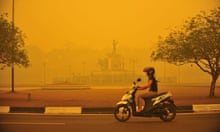Raging Indonesian forest fires have advanced into dense forest on Borneo and now threaten one third of the world’s remaining wild orangutans, say conservationists.
Satellite photography shows that around 100,000 fires have burned in Indonesia’s carbon-rich peatlands since July. But instead of being mostly confined to farmland and plantations, as they are in most years, several thousand fires have now penetrated deep into primary forests and national parks, the strongholds of the remaining wild apes and other endangered animals.
Alarmingly, 358 fire “hotspots” have been detected inside the Sabangau Forest in Borneo which has the world’s largest population of nearly 7,000 wild orangutans. Elsewhere, fires are raging in the Tanjung Puting national park, home to 6,000 wild apes, the Katingan forest with 3,000 and the Mawas reserve where there are an estimated 3,500.
“I dread to think what it will mean for orangutans. For them and other species, like the secretive clouded leopard and the iconic hornbill, the situation is dire and deteriorating by the day,” said Mark Harrison, director of the UK-based research and conservation organisation Orangutan tropical peatland project (OuTrop), which has been studying the tropical peat swamp forest of Sabangau since 1999.
“In their undisturbed, flooded state, peatland forests are naturally fire-resistant. But decades of poor peatland management practices, including extensive forest clearance and canal construction, has drained the peat, putting the whole region at high fire risk when the inevitable droughts occur,” Harrison said.
Prof Susan Page, a geographer at the University of Leicester and an expert on peatland conservation, said: “Dry peat ignites very easily and can burn for days or weeks, even smouldering underground and re-emerging away from the initial source. This makes them incredibly difficult to extinguish. Smouldering fires produce high levels of harmful gases and particulates.”
Little is known about the precise effects of smoke inhalation on animals but the lungs of animals are similar to those of humans, so it is expected to make them sick and unable to feed.
Teams of volunteers have been trying to put the fires out but many are out of control. In Sabangau forest one fire has already burned over 500 hectares and is threatening the renowned research station managed by the Centre for International Cooperation in Sustainable Management of Tropical Peatland (CIMTROP) at the University of Palangka Raya, according to OuTrop director of conservation, Simon Husson.
The wildfires across Indonesia are now thought to be responsible for up to 500,000 cases of respiratory infections, and six provinces have declared a state of emergency.
“People are choking in the smoke and one of the world’s last great rainforests is burning down,” Husson said. “The only way to tackle this is with huge manpower on the ground, supported by intensive and sustained aerial water-bombing. Mobilising these resources requires raising international awareness of the catastrophe unfolding in Sabangau.”
With two warships positioned off the island of Borneo to evacuate children and some of the most affected families, and no rain expected for at least one month, the pollution threatens to overwhelm the region’s already stretched health services.
In Palangkaraya, capital of Central Kalimantan province on the island of Borneo, where many of the most serious fires are raging, the office of Meteorology, Climatology and Geophysics (BMKG) reported that minute PM10 particles had reached the “very dangerous” level of 2,483 milligrams per cubic metre with visibility under 30m in 350 locations.
The city’s chief medical officer stated that its health services had diagnosed 5,931 people with acute respiratory infections since July – around 3% of the population. Schools have been closed in the city for five of the last seven weeks.
“We have days we call ‘Hari Kuning’ (‘yellow days’). This is when the dense, sound-deadening smog somehow absorbs the light from the invisible sun turning everything a surreal sepia colour,” one Palangkaraya resident told the Guardian.
“Masks available locally are ridiculously inadequate – and some people don’t bother to wear anything at all,” she said. “Not everybody here seems to be aware of the health risks. There are already reports of miscarriages and premature deaths among babies, the elderly and infirm directly attributable to the smoke.”
The smoke drifts across the region at heights of between 3000m-5000m and varies in intensity from day to day and island to island. “It’s been two months since people in Kerinci [central Sumatra], have seen blue skies.,” said Luke Mackin who works with ecotourism company wildsumatra.com.
“The government has closed schools so that students can be safe at home – except people’s homes are not sealed at all, and are no safer than being at school. So, millions of children are missing out on their education. All of the tourism in the region is pretty much dead, which is devastating for the families in this rural area who rely on it,” said Mackin.
The pollution will cost the Indonesian economy billions of dollars and has led to demonstrations. In Sumatra, hundreds of teachers rallied at the weekend in Pekanbaru, the capital of Riau province. “People are getting angry. They used to accept a certain amount of smog but this year it’s much worse,” said one protester.





Comments (…)
Sign in or create your Guardian account to join the discussion